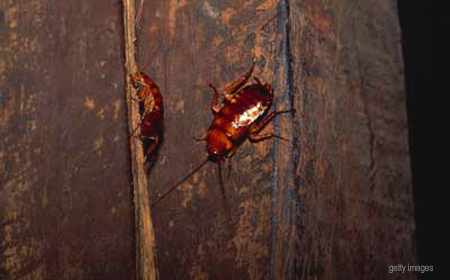Hot and humid. Summer is just around the corner and once cockroches are in your home, getting to know them is your least concern.
Cockroaches can infest the cleanest of living spaces. When house hunting, they can check out your place by crawling through tiny gaps around doors, pipes and other open spaces. Contrary to popular belief, they aren't simply attracted to messy households, although that will extend their stay. Instead, common roaches that invade homes seek out warmth, moisture and darkness. Pizza left sitting out on the counter is just an added bonus.
Cockroaches have become such widespread pests because they thrive on very little. The insects require three things: water, food and warm shelter. These nastry critters have lived off the bare essentials with few changes since their creation 320 million years ago. Even the areas they choose for nesting indoors are minimalistic -- cramped spaces in walls, behind picture frames, under sinks and elsewhere.
Ways to get rid of cockroaches
Before you start spraying pesticides on every open surface of your house in an attempt to kill the roaches, you need to strategize. Plotting out an attack on a group of insects may sound borderline crazy, but you'll have more success if you plan ahead.
To do that, let's go back to those three things that roaches need: warm shelter, food and water. Taking away those elements is like serving them an eviction notice.
First, you need to figure out where the bugs have set up camp. If you've noticed them in an isolated area, such as the kitchen, that's a decent clue they're hidden away in there. For a more precise indicator, put out strips of roach traps that are coated with a sticky glue to stop them in their tracks. The heavier trafficked strips should be closest to their nest. You can use this method repeatedly throughout your mission to check your progress and whether they've changed locales. Also check around for droppings, egg sacs and shed exoskeletons.
While you're waiting on your trap results, you've got some cleaning to do. Even if you keep things tidy, you probably haven't covered every spot that serves as a feeding trough. Items in particular that you should get rid of include:
- Piled newspapers
- Cardboard boxes
- Paper bags
- General piles of clutter where cockroaches can hide
Cockroaches are especially drawn to paper products because they readily absorb a certain pheromone, or chemical attractor, that roaches emit. This serves as a GPS system by communicating the insects' locations to other ones around and leaves a trail for them to find their ways back and forth.
It's also time to give your house, especially your kitchen, an intense bathing. Get any fresh fruits, vegetables and bread off the counters and into airtight containers. Check through your groceries and secure open bags and boxes. Clean the eyes on the stove, inside the stove and oven, the microwave and other appliances. Pay attention to grease because even small spots of it are like foie gras for roaches. Sweep or vacuum behind large appliances and remove any food waste at the bottom of dishwashers.
After all of that, you must maintain a high level of cleanliness to eliminate your pest problem. That means not leaving dirty dishes in the sink, sweeping routinely after cooking and never abandoning food on countertops. Take your trash out regularly as well.
Perhaps more than food, roaches seek out watering holes. For that reason, search around for places that could collect water, such as plants, the drip plate under your refrigerator or condensation around pipes. Try to keep those areas dry, especially at night when roaches feed.
Set up a cockroach motel
Roach baits and boric acid are your next line of defense if those previous steps don't reduce the population. You can purchase boric acid as a powder and lightly dust it in the cracks under sinks and appliances and behind cabinets. Don't apply near food preparation areas and be sure to store out of reach of children and pets.
Many of the ready-made sprays supermarkets sell are contact repellents. That means you have to actually strike an insect with the liquid to kill them. Repellents in general also won't cure your problem forever. They simply keep insects at bay, potentially moving them to another area of the house or apartment, depending on where you live. For killing the insects, stomach poisons, such as the commonly-used boric acid, may be more effective.
There are many other pesticide categories companies offer, including:
- Desiccants: substances that dry out roaches to kill them
- Ready-to-use spray: premade sprays, which are often repellents
- Emulsifiable concentrates: sort of like the frozen orange juice of pesticides. A concentrate to which you add water.
- Aerosols: most work as contact repellents
Knowing where and how to apply your poisons also influences your results. For instance, thin layers of boric acid powder are more effective than thicker ones. After putting on your protective eyewear, breathing mask and gloves, you want to go back to those cracks and crevices we've been talking about. Apply your pesticides in those spaces, taking care to not damage any appliances.
If, after all this effort, you flip on the switch in your kitchen and behold the skittering of cockroaches, don't lose hope. Many pesticides take at least a week to produce visible results.
Some commercial roach pesticides contain toxic chemicals that can be harmful to humans. If you choose to use these in your home, do not leave them in child-accessible areas and be careful about how you dispose of them. Read labels for proper application procedures to protect your family and your pets. When applying pesticides, protect your eyes, lungs and skin from contact as well.
how stuff works

